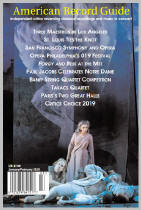Texte paru dans: / Appeared in: |
|
|
Outil de traduction ~ (Très approximatif) |
|
|
Reviewer: Catherine
Moore Splendid in every way, this first recording of Cipriano de Rore’s first publication, Madrigali a Cinque Voci of 1542, is revelatory. In 2015 the Blue Heron ensemble and UC Davis scholar Jessie Ann Owens were jointly given the Noah Greenberg Award from the American Musicologi-cal Society. It supported the collaboration that led to this recording. The result is a model of how performers, scholars, and record labels work together to bring unknown music to life. The first voice you hear is not a singer but a reader, Alessandro Quarta. Each of the poetic texts is read before Rore’s setting is sung. Most of the poems for the 20 pieces are sonnets, and many are by Petrarch. Quarta reads with meaning, expression, changes in timing and volume, inflection, pauses, and nuance. He interprets the poems much like musicians interpret notes.
The booklet essay by Professor Owens is aptly titled “Uncovering the Secrets of the 1542 I Madrigali A Cinque Voci” because close examination reveals a symmetry of design that—though not obvious—is unlikely to be accidental. There’s a clear sequence of modes 1 through 8; the volume divides into a “pain of love” first half and a “resignation at her loss and [the poet’s] attempts to keep her present even after death” second half. The first is in minor modes; the second major. The 1542 collection has long been celebrated for its influence on music history, but because none of its numerous re-editions retains the original ordering of the pieces, that underlying structure has been largely unknown. This music could have no greater champions.
One reason there are very few recordings of any of Rore’s music is that it’s very difficult. Not only is Blue Heron technically expert, but its 6 singers (SCtTTTB) also blend their individual timbres into an engaging and powerfully expressive ensemble sound. It’s like weaving: separate colorful textured fibres strengthen each other to make the fabric whole. Director Scott Metcalfe (not one of the singers) leads with confidence, discipline, and imagination. At each new piece I found myself following the words very closely when they were spoken by Alessandro Quarta, then mostly I set aside the texts while listening to the music. It was a new way to listen, and I relished it. After you get this recording, get also the excellent Rore program that celebrates several versions of the composer’s ‘Ancor Che Coll Partire’ (Ricercare 355, S/O 2015). As for other Blue Heron recordings, John Barker praised their “Peterhouse Partbooks 5” (1007, J/A 2017: 205) and sacred music by the Tudor composer Richard Jones and others (1005, J/F 2016). Extensive notes, texts, translations in a 60-page booklet with illustrations and musical examples. | |
|
|
|
|
Cliquez l'un ou l'autre
bouton pour découvrir bien d'autres critiques de CD |
|




